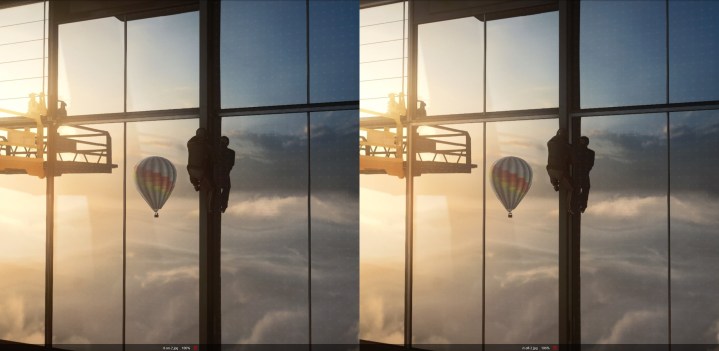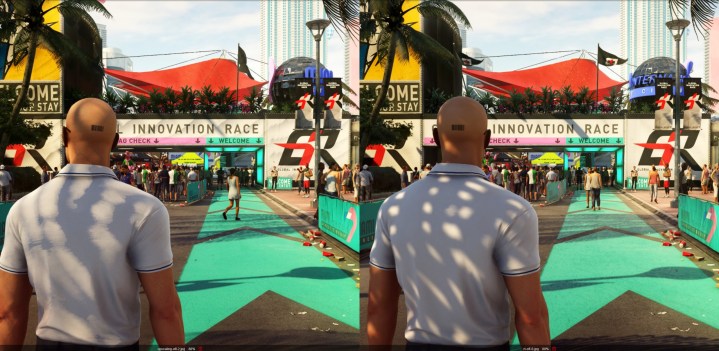Nvidia and AMD revealed at Computex 2022 that Hitman 3 would receive support for ray tracing and both Nvidia and AMD’s supersampling technologies, following an announcement from developer IO Interactive late last year. The update is here and I’ve had a chance to try it out, but I wasn’t left salivating over all the visual glitter like I expected.
Ray tracing can certainly make visuals more realistic, but in this game, it proves that adding ray tracing to all games isn’t necessary — especially when it tanks performance without adding much in terms of noticeable benefit. Hitman 3 is a reality check, especially if you think ray tracing is the be-all and end-all of graphics.
Hitman 3 doesn’t need ray tracing

Hitman 3 has very little to gain from ray tracing, and spending some time with the new update only confirmed that for me. The update brings ray-traced reflections and shadows, which you can toggle on individually. But after playing through several missions and capturing around 50 screenshots, it’s hard to see the benefit.
You can see an example of that from the Dubai level above. The ray-traced version (left) shows the beam that Agent 47 is climbing cast slightly more shadow, but these two scenes are almost identical. If they weren’t side by side, I wouldn’t be able to tell you which one is using ray tracing, certainly.
That’s not to say ray tracing isn’t doing anything, just that it’s not doing very much. I noticed the reflections most on semitransparent reflective surfaces (mostly glass), where ray tracing shows reflections that wouldn’t normally render. You can see an example of that in the Maldives level from Hitman 2 below (ray tracing is on the left).

I captured another example in the Miami level (below), where you can see the ticket booth window reflecting the people in line with the ray-traced version (left).

The issue is that these comparisons only hold up in one-for-one screenshots. While playing, they’re hard to notice because Hitman 3 already has fantastic reflections and lighting. In many cases, you’re getting ray-traced reflections even without ray tracing turned on, which both the Maldives and Miami levels confirmed.
For the window in Miami, it showed the wonderful ray-traced reflections from a distance, but that reflection quickly shifted once I took a few steps toward the window. Hitman 3 already uses screen-space reflections, and even with ray tracing turned on, it will default to these reflections when you’re up close. Below, you can see how the middle and right images (ray tracing on and off, respectively) look identical despite the ray-traced reflection in the left image.

In this scene, ray tracing is helping the shadows more than anything else. They look fantastic, but that wasn’t my experience through all of the levels I looked at (more on that in the next section).
In the Maldives, I found similar shifting to the default reflections. The windows on each hut (below) look much nicer from a distance with ray tracing turned on, but they have the exact same reflection when you get up close to them.

There are some visual benefits to turning on ray tracing in Hitman 3, but the vanilla build offers much of the same experience, especially concerning details you’ll actually look at. Unfortunately, the pros of ray tracing in Hitman 3 are massively outweighed by the cons.
Ray tracing can look much worse
Hitman 3 wasn’t designed with full-on ray tracing in mind, which leads to some awkward scenes where turning ray tracing on actually makes the game look worse. I was especially disappointed in the neon-dripped Chongqing level, where I expected ray tracing to shine the most.

In the ray-traced image (above left), you can see the left wall doesn’t hold a reflection like the image without ray tracing. The ray-traced image is certainly more realistic — a rain-soaked wall in an alley wouldn’t reflect lights that are a mile or more away — but does it look better? Not really.
It’s a case of expectation versus reality. IO Interactive clearly designed this scene so that it was drenched in the neon glow of a Chinese city, which means bending the rules of how light behaves to achieve an artistic vision. Turn on the ray tracing switch, and those intentions are lost.
Chongqing was disappointing, but the Miami level was downright shocking. With ray tracing on, some shadows showed nasty interactions with the highly detailed surfaces in the game. You can see the streaking and aliasing present on Agent 47’s back in the ray-traced image (below left), which isn’t present with ray tracing turned off.

As my screenshots from Miami show in the section above, ray tracing renders shadows that otherwise wouldn’t be in the game. It’s a perk, but when a shadow that’s taking up a significant portion of the screen looks much worse, it’s time to prioritize.
I’m not knocking Hitman 3 here. It’s a beautiful game, one of the best games to show off the power of your gaming PC. The problem is that ray tracing is coming in on top of what is already an excellent lighting implementation that saves on performance where it needs to without sacrificing too much image quality.
And performance is the key metric for ray tracing in Hitman 3 because it absolutely tanks your frame rate.
Hitman 3’s ray tracing tanks performance

You may be wondering: So what? Ray tracing may not be perfect, but it still offers some visual advantages. It’s hard to justify ray tracing in Hitman 3 when performance is brought into the mix, though. Turning ray tracing on tanked my frame rate to around a third of what I achieved with it turned off.
That’s not surprising since ray tracing is demanding in any game that supports it, but AMD’s FidelityFX Super Resolution (FSR) and Nvidia’s Deep Learning Super Sampling (DLSS) don’t do enough to combat the problem. Even with the most aggressive Performance mode of FSR, ray tracing is 36 frames behind. Keep in mind, as well, that the run without ray tracing is at native resolution.

FSR and DLSS don’t look great at their most aggressive modes, either. You can see an example of that in Berlin above. The DLSS (middle) and FSR (left) images show a nasty wash on the puddle in the bottom left, and they both showed shimmering and flickering on the illuminated wall toward the back.
A bad showing for ray tracing
Ray tracing can elevate the look of a game, but it’s not a guarantee. In a relatively slow third-person stealth game like Hitman 3, ray tracing doesn’t make sense when balanced against the reflection and lighting options available today, as well as the performance cost of ray tracing.
Contrary to Nvidia’s RTX marketing and the claims of current-gen consoles, ray tracing is not an essential feature in AAA video games. It’s unnecessary in many cases, and Hitman 3 is a prime of example of that.




